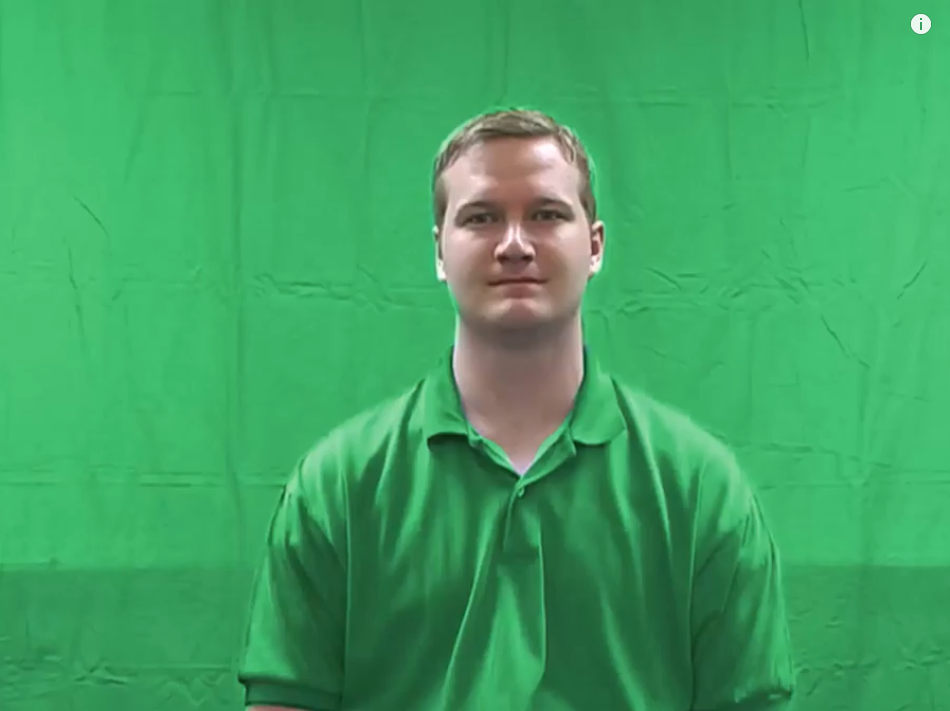Description
Instructor and course Introduction videos are a best practice in online course design and satisfy Specific Review Standards 1.1, 1.2, 1.7, and 1.8 on the Quality Matters Higher Education Rubric, Sixth Edition.
An instructor introduction video in an online course creates a sense of connection between the instructor and the students. It presents the instructor as professional as well as approachable.
A Course introduction video gives students a general overview of the course, presents a schedule of activities, discusses methods of communication, and helps students understand the purpose of the course. The course introduction video should also communicate information about prerequisite knowledge students need to be successful in the course.
This Guide Will Help You to:
Reusable vs. Disposable Video Assets
When considering videos for your course, it is highly recommended to create reusable video assets or videos that can be used across multiple semester and courses. Reusability gives the advantage of not having to create multiple or last-minute videos each time the course is taught.
A disposable video asset is too specific (referencing course dates, sections, or term) and only good for perhaps the term the course is offered. This type of video must be created for every section or term, requiring additional preparation time and recreation work.
To create a reusable video asset, take special care to avoid any mention of:
-
A specific course name or number in the Instructor Introduction
-
The term or any specific dates in the course
-
Details that may apply to only one iteration of a course
Also, in a course introduction video, avoid restating information that already exists in the course syllabus.
Create an Outline
Before recording an introductory video, it is highly recommended to first create an outline of talking points or topics to cover in the video. An outline should include essential information students need to know about the instructor and course. The outline also ensures a smooth and logical flow in the delivery of the information.
Note: Creating an outline will help to keep the video at a reasonable length, and file size. A good benchmark for video length is approximately 3-5 minutes.
Consider including the following information in your introductory videos:
Instructor Introduction Videos
-
Welcome students by introducing yourself, your title and field of expertise
-
Your educational and work background
-
Why you love your discipline and the different courses you teach
-
What excites you about online teaching and how to avoid common "pitfalls" as online students
-
(Optional) Personal information, such as your hobbies or your family/home life
Course Introduction Videos
-
Course number/name and how the course fits into the curriculum of the program
-
The purpose of the course
-
The relevance of the course to the students
-
How the course is designed/organized and delivered to students
-
How/why the course design will help the students achieve the course goals and learning outcomes/objectives
-
Your expectations for student participation
-
Any special instructions for assessments or assignments
Write a Script
A script is a fleshed out version of an outline stating exactly what you plan to say while recording the video. The script should be, word-for-word, what will read into the camera.
Warning: Federal law requires multimedia content to be compliant with Section 508 of the Rehabilitation Act. Essentially, this means that videos should be closed-captioned or text transcripts are made available for any enrolled students. Therefore, it’s a good idea to write out your script word for word so you’ll have a transcript already prepared when you have finished recording. Accessible course content is a requirement of Specific Review Standards 8.2, 8.3, and 8.4 of the Quality Matters Higher Education Rubric, Sixth Edition. Contact the ITRC to see how your course videos and other online resources can be made accessible to all students.
Set-Up a Webcam
The most common camera option for self-recorded videos is a webcam. The webcams can be external (an add-on device that can be moved and repositioned) or internal (often built into a laptop, above the top of the screen). In this section, you will learn how to set up your computer webcam and position yourself for optimal recording.
Check Webcam Set-up
If you are using an external webcam, it is important to follow the installation and setup instructions that came with the device. If you are using your computer’s built-in webcam, your webcam should already be set up. Next, you want to check your microphone settings before you begin recording. This allows you to verify that the proper microphone is being used to record your audio and that the volume is at the acceptable audio level for recording. The following online resources will help you set up and test your microphone:
Position Yourself Near the Camera
Webcams can have a limited field of view (what the camera can see), and recording with them can be deceptive. While recording, you may be looking at a very large window on your computer’s screen. This gives the impression that students will be watching your video at that size as well. In reality, your recording may be viewed at a significantly smaller size (try watching a YouTube video for context). It’s essential that you be comfortably close to the camera to effectively use that space. Here are three photos of me for context. My face and my features start to become harder to distinguish as I move just a few feet away from the camera. Now imagine your students trying to watch a video of you at these different distances. Which would you prefer they watch? Maintaining a close distance is essential, because it helps preserve the nonverbal cues you express with your face and gestures.
Eyes on the Camera
When recording, it is important to look directly at the camera when you speak, not your screen or your keyboard as you talk and type. When you look directly at the camera, in the recording, you will be looking directly at your students.
|
Looking at the Camera
|
Looking at the Screen
|
Typing/Looking at the Screen
|
|

|

|

|
Set the Lighting
The most important element of any recorded video is proper lighting. This section discusses simple techniques to maximize the lighting around you in your recording space.
Lights in front, not behind
When it comes to lights in our workspace, we typically place a table or floor lamp behind where we sit. In a work setting, this is practical because the light illuminates the things in front of us (like books we’re reading). When recording a video, however, having a primary light source set behind you can ruin the quality of the video. In this configuration, the light source is not illuminating your face, the most important part of the video.
|
Primary Light in Front
|
Primary light behind
|
|

|

|
Here are two photos using natural light in front of the subject and behind the subject. There are some substantial differences between these two. Take note of the following in particular:
-
In the second photo, the color of the person is difficult to identify.
-
In the second photo, the background is washed out
-
In the first photo, the definition of the person’s hair and face is substantially better
While neither photo is ideal, there is a significant difference in the second photo when lighting is in front of the person. You should, however, also avoid placing the light source directly in front. While it illuminated the person’s face better compared to the first photo, it also washed out the person’s complexion, flattened the image (no real depth) and “blends” the person into the background.
Use a Three-Point Lighting Technique
For the best results, use additional light sources to set up a Three-Point
Lighting system. The Three-Point Lighting technique is commonly used by professional photographers and videographers and would be an easy system to set up in your home or office using a combination of desk lamps, table lamps, and floor lamps - whatever you have on hand.
A Three-Point Lighting system uses three different points of light to illuminate the camera’s subject. Select the purple hotspots on the image below to learn more about the Three-Point Lighting system.
Prepare the Recording Environment
Find a quiet place
It is essential to find a quiet and distraction-free location in which to record a video. Public spaces rarely make good recording locations. Also, you should also consider potential distractions at home (kids playing, dog barking, partner vacuuming) or in the workplace (colleagues talking in the hall, phone ringing) All of these factors can affect the overall quality of your recording, or distract you from being able to successfully deliver your content.
Don’t blend in
Regardless of lighting or the quality of the video camera, a lack of contrast between you and your
background can ruin the quality of the video. There are two simple steps to follow to establish contrast in your videos:
|
Recommend
|
Avoid
|
|

|

|
Recording Your Video
The process of recording yourself on video can be awkward or uncomfortable if you are not used to hearing and seeing yourself on video. It is normal to be self-critical or feel like you did not perform at your best in the video recording. The following advice will also help improve the quality of your recordings. Always remember that you are not expected to perform like a television or movie actor in your course videos. Here is some advice to help you look and feel more comfortable in front of a video camera.
Use your voice
Avoid sounding monotone, vary the tone of your voice, as well as your speaking rate. With that in mind, try not to go overboard too in your delivery. If you’re using an external microphone for your audio, try to find and use a Pop Filter. A Pop Filter is a small screen that rests between you and the microphone that dampens “pops” from sounds like the “t” and “p.” These sounds create “pops” that go outside the normal audio recording range and decrease the audio quality.
Relax your movement
Try to relax on camera. You will appear more approachable to your audience if you appear relaxed. Avoid unnecessary distractions (e.g., dangly or sparkly jewelry, constantly shifting in your seat, etc).
Slow your gestures, if you tend to “talk with your hands”, which can distract your audience. Also, swift movements don’t always translate well in the recorded audio and can make your movements appear blurry on video to the rapid motion. Apply this same rule to any objects you may be physically demonstrating or if you are using a screen capture (sharing your computer screen). Hold the object near the camera and move it slowly.
Be prepared
Keep your script nearby. If possible, keep your script open on the screen in front of you. Doing this will make it much less noticeable when you’re reading your script (since you won’t have to look away from the screen and the camera to do so). Remember to maintain eye contact with the webcam.
If you’re recording a lot at once, your throat may go dry and affect your ability to speak with consistency. Keep a glass of water nearby and remember to frequently drink water, use hydrating cough drops, and take frequent breaks between recordings.
Save your video
One of the most overlooked areas of video creation is determining where to save your file, and what format to save it in. Ideally, you’ll want to save your video as an .MP4 file. This file format reduces the size of the video file without reducing the overall quality. They also meet the file type requirements for uploading to video sharing sites such as YouTube and Google Drive and can be played on any operating system, browser or device.
Host your video in Google Drive and Share to Moodle ISU
The best way to share your video with the students in your course is to upload your video to your ISU Google Drive account. Once the video has been uploaded to Google Drive, you can use a shared URL link or the HTML Embed Code to insert the video directly into a Moodle ISU content item. When students go into your Moodle ISU course, they simply click on the video link and are taken directly to the video hosted on Google Drive. You can choose whether to require students to log in to their ISU Gmail account to access the video or to share the video with anyone who has the URL.
Seek Further Assistance
The ITRC can help you with many of your video recording and editing needs. For additional assistance please contact, ITRC at (208) 282 5880 or itrc@isu.edu